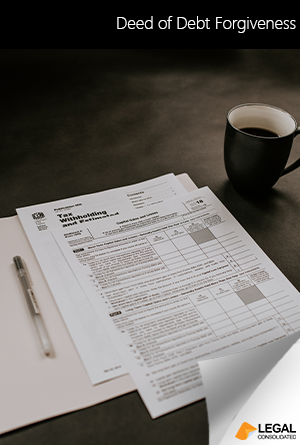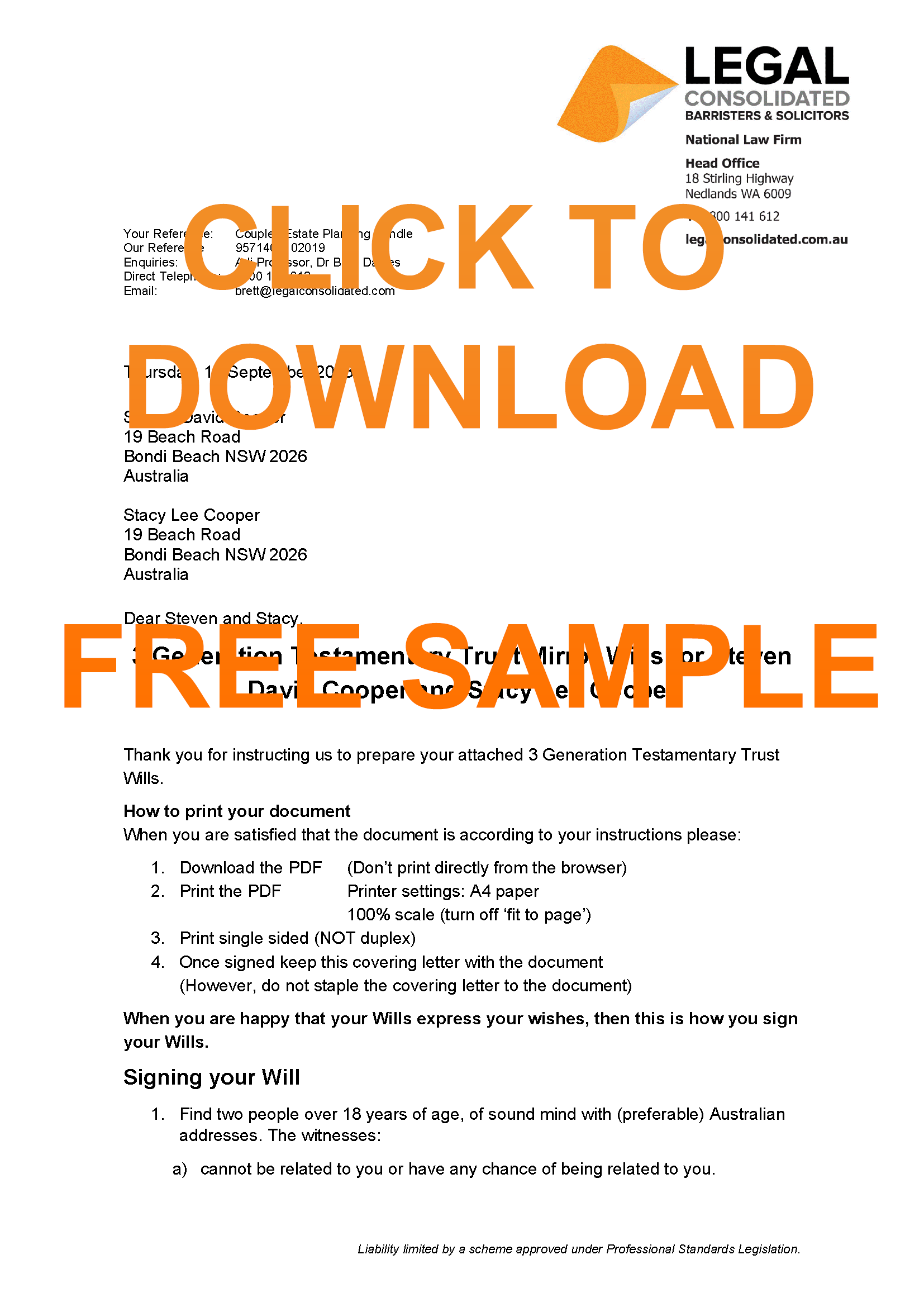How Legal Consolidated’s Family Trust Annual Distribution Minutes operate under section 100A Income Tax Assessment Act 1936.
What is a Deed of Debt Forgiveness?
A Legal Consolidated Deed of Debt Forgiveness is a legally binding document that outlines the agreement between a creditor and a debtor to forgive or release a debt owed by the debtor. The Deed formalises the process of forgiving a debt. This means the debtor is no longer obligated to repay the amount owed. The creditor decides to waive the debt for for ‘natural love and affection’. There is no money changing hand. The creditor is just ‘good-hearted’.
What is the difference between a Deed of Debt Forgiveness and a Deed of Gift?

A Legal Consolidated Deed of Gift is a legal instrument. It is used to transfer ownership of property or assets from one party (the donor) to another (the recipient) without any exchange of money or consideration. When you build a Legal Consolidated Deed of Gift you can gift property, valuable items, money, and other assets. A Legal Consolidated Deed of Gift sets out the details of the gift, including a description of the gifted property, the identities of the parties and the intention of the donor to transfer ownership without anything in return.
Both the Legal Consolidated Deed of Debt Forgiveness and the Deed of Gift have a sense of kindness. You are giving a benefit to a person for free. Neither has any payment attached.
Can a Deed of Gift be done via a Minute or Resolution?
A Minute only reflects something that has happened. So a Minute or Resolution does not work. A minute is not an ‘agreement’ between two parties.
Also, the ‘agreement’ requires several things. An agreement requires ‘consideration’. But when you agree to forgive a debt you do not have consideration. Your agreement must be done as a ‘Deed’. This overcomes the need to have consideration.
When you build the Deed of Debt Forgiveness on Legal Consolidated’s website it comes as a Deed.
ATO claims there is no longer ‘love’ between a Family Trust and a beneficiary
The ATO released Draft Taxation Determination 2019/D9. It comes out 7 months after it withdrew ATO ID 2003/589 on 6 February 2019. TD 2019/D9 was finalised in Taxation Determination TD 2022/1.
In TD 2022/1, the ATO now takes the view that debts can only be forgiven for “natural love and affection” between humans, acting as humans. Not humans acting, as say, a trustee of a family trust or unit trust.
The ATO’s new view is that “the creditor cannot be a company or an individual acting in the capacity of a trustee”.
As part of the explanation of the ATO’s view, it notes that “the notion of forgiveness is confined by the use of ‘natural love and affection’. That term serves to identify the motivation for forgiveness. The required connection between that motivation and forgiveness is only satisfied when the creditor feels natural love and affection.” It is a human trait. While you can love your car and your dog, perhaps you cannot love your company and your trust! The ATO has made its way into your home and now into your bedroom. The ATO now claims to know your inner thoughts.
TD 2022/1 turns on its head the ATO’s old interpretation of section 245-40(e) Income Tax Assessment Act 1997.
Have a read of section 245-40(e). Nowhere in the legislation is there a requirement that a creditor is a natural person. The only reason for forgiveness is ‘natural love and affection’.
The unelected ATO has now decided to create new law.
Forgiving a commercial debt under Paragraph 245-40(e) Income Tax Assessment Act 1997
Paragraph 245-40(e) Income Tax Assessment Act 1997 excludes a debt forgiven for reasons of natural love and affection from the application of the commercial debt forgiveness rules.
In other words, under Division 245 debts that a creditor forgives are offset against amounts that could otherwise reduce taxable income. Paragraph 245-40(e) excludes a debt that is forgiven for reasons of natural love and affection from those offset provisions.
What about old Deeds of Debt Forgiveness?
The ATO does not “devote compliance resources to debt forgiven before 6 February 2019″. This is because the Determination takes a different view to the old ATO Interpretative Decision ATO ID 2003/589 Commercial debt forgiveness – can a company forgive a debt for reasons of natural love and affection? (withdrawn on 6 February 2019).
However, Deeds of Debt forgiveness for companies and trusts after that date may well be legal and enforceable, but incur the wrath of the ATO. Tread carefully.
Family Court decisions since 6 February 2019 may have to be reconsidered if there was forgiveness of debt. Legal Consolidated does not advise in this area of law. And we do not advise on the taxation implications of a Deed of Debt Forgiveness.
Note the ATO’s position is that neither a trust nor a company, as the creditor, can express ‘feelings’ such as ‘love’ and ‘affection’. Seek advice from your accountant on these matters and the taxation issues BEFORE you sign a Deed of Debt Forgiveness.
So, in summary, the ATO does not ‘devote compliance resources’ to apply the views expressed in this Determination for debts forgiven before 6 February 2019 that would have been covered by ATO ID 2003/589. However, if the ATO is asked or required to state a view (for example, in a private ruling or submissions in a litigation matter), the Commissioner does so consistently with the views set out in this Determination.
No tax advice on the forgiving of a debt
Legal Consolidated provides no tax advice on a Deed of Debt Forgiveness.
For the tax consequences of a Deed of Debt Forgiveness, generally or in your specific set of circumstances, speak with your accountant or taxation adviser.
Further taxation issues to discuss with your accountant before you forgive a debt
Additional issues to discuss with your accountant when you forgive Family Trust UPEs and other debts include:
- is a deduction for the release of debt available?
- do the commercial debt forgiveness penalties apply?
- any Fringe Benefits Tax?
- Part IVA ITAA 1936
Legal Consolidated does not provide advice on these taxation issues. Speak with your accountant before you build this Deed of Debt Forgiveness.
Forgive Family Trust UPEs with a Deed of Debt Forgiveness
Your Family Trust distributes $30,000 to your daughter each year for 10 years. Your Family Trust pays the tax of $2,000 per year on behalf of your daughter. Therefore, there is an ‘Unpaid Present Entitlement’ (like a debt). Your Family Trust owes your daughter $280,000. An ‘Unpaid Present Entitlement’ is the money that the Family Trust owes the beneficiary. You must get her to forgive Family Trust UPEs regularly.
Your daughter, of course, never gets any of this money. You just used her low marginal tax rates to pay less tax. Your accountant reminds you that your daughter (or her ex-husband or trustee in bankruptcy) can now ask for that money. After all, it is her money.
To get rid of the debt she signs a Deed of Debt Forgiveness. Get her to sign the same Deed of Debt Forgiveness each financial year. Therefore, if your daughter goes bankrupt, feral, divorces or dies your Family Trust owes her nothing.
Have a son? Have other children? Distributed to yourself? Build a separate Deed of Debt Forgiveness for each of you.
However, you need to check with your accountant as to the taxation implication of the forgiveness of debt. Legal Consolidated provides no taxation advice. You need to seek your own advice on the taxation issues.
Do I need a separate Deed of Debt Forgiveness for each Beneficiary?
Yes. You need a separate Deed of Debt Forgiveness for each beneficiary. Following on from the above example, if you want Dad, Mum, Child and Auntie to forgive the debt that the Family Trust owes them, then build four separate Deeds of Debt Forgiveness.
Separate Deeds, for each person, also help if the ATO ever wants to review your Deed relationship.
Each year, can I re-use the same Deed of Debt Forgiveness for the same parties?
That is correct. As often as your accountant requires, print the Deed of Debt Forgiveness and get Dad, Mum, Child and Auntie to sign and date each one. You never need to build another Deed of Debt Forgiveness for those particular four people again.
So, for example, you have seven children. Then you need to build and pay for seven Deeds of Debt Forgiveness. But that is it. For each child, as your accountant directs, you log back in and print out the Deed again (or photocopy) their Deed of Debt Forgiveness for that particular child.
If you had an eighth child, then go back online and build and pay for, yet another, Deed of Debt Forgiveness.
How does a Deed of Debt Forgiveness forgive a Family Trust UPE?
The Borrower owes you money. In the Deed of Debt Forgiveness, you forgive the debt for ‘love and affection’. The debt has gone. The borrower no longer owes the lender any money. However, get tax advice from your accountant on whether you should do so.
What happens when you die with UPEs?
The case McCarthy v Saltwood Pty Ltd [2020] TASSC 19 is a Tasmanian Supreme Court decision. It is a dispute between a beneficiary and the trustee of a discretionary trust. It arises from a dead beneficiary loan account.
It highlights the poor habits of some clients. Make sure that trustee resolutions and director minutes are legally prepared. Journal entries are a waste of time.
McCarthy v Saltwood Pty Ltd [2020] TASSC 19
In McCarthy v Saltwood Pty Ltd [2020] TASSC 19 Saltwood Pty Ltd is the trustee of the McCarthy Family Trust. The Family Trust carries out farming. The same Family Trust also owns the farming land. To own both the trading business and the land in the same trust is poor asset protection.
John McCarthy runs the farm and controls the Family Trust. John is married to Eunice McCarthy. They have 6 children.
John dies.
Farmer John’s promise to his son Andrew
Andrew, a son, works on the farm all his life. Andrew claims his Dad said:
When I die, Andrew, you take over the farming business and get part of the farming property.
Family trust loan accounts form part of a dead person’s estate
John ran the farm. John controlled the family trust accounts.
John distributes the family trust profits to himself, his wife and Eunice. But, as is usually the case, the family trust does not pay the money to John and his wife. Instead, a type of loan called an ‘unpaid present entitlement is created. This results in a joint ‘loan’ account. The family trust owes money to John and his wife.
On John’s death, Eunice claims that John’s share of the loan passed to her. This is under John’s Will. Like a car or a house, a UPE is an asset of the deceased estate.
Annual Family Trust distributions done by journal entry are deficient
The family trust, now controlled by Andrew, rejects Eunice’s claim. The family trust disputes the ‘loan’ balance on the family trust financial statements. The family trust claims that income distributions made to John and Eunice were invalid. This is because there was no annual family trust distribution statement. Therefore, the annual trust distribution meetings did not satisfy the requirements. This is under the Trustee company’s constitution.
Journal entries are not Deeds of Debt Forgiveness
John’s accountant quickly puts together some journal entries after John dies. The Court looks at the accountant’s journal entry for $791,698.
This reduces the money that the family trust owes Eunice. The journal entry claims that Eunice has forgiven the loan account.
The accountant claims the forgiving of $791,698 by Eunice allows the transfer of the farmland from the family trust to Andrew. But in effect, the accountant has aided and abetted an attempted theft of $791,698 from Eunice. Smells like elder abuse.
The accountant correctly notes that family trust assets do not form part of John’s estate. The accountant’s journal entries made the loan accounts to other beneficiaries “disappear and seem to be absorbed into the joint loan account of [Eunice] and John”. The Court sees no legal basis for such transactions.
The Court holds that the trust income distributions are valid. The family trust must pay the ‘loan’ amount owed to Eunice. Andrew seemed a little shocked by this. Andrew hoped to inherit the farming operations after his father’s death. This is without the debt.
Andrew, the boy, is a trusting fool. The accountant while a loyal servant to his dead master, messed up.
Warning: do not use journal entries for family trust distributions. Instead, get legally prepared family trust distribution statements.
Journal entries are not evidence of forgiveness of debt
What makes a journal entry effective? There must be a legal basis for the transaction. This requires documents and deeds that support that legal basis.
Unpaid present entitlement v’s bankruptcy and divorce
Question: Dear Dr Davies, some of our family trust clients have children approaching 18 years of age. (Therefore, the minor’s 66% penalty tax rate no longer applies.)
The Family Trust’s Trustee is often Dad (the man or straw) or his corporate trustee. Dad wants to start distributing serious amounts of money to his 18-year-old child. This is often between $18,200 to $180,000 each financial year.
In effect, the Family Trust will owe the child this money. Or, as you like to call it, an Unpaid President Entitlement (UPEs).
I am concerned, as I can remember attending one of your lectures, you mentioned, that these undistributed beneficiary loans are counted as assets for divorce and bankruptcy.
Example of a UPE being forgiven:
Trustee Dad distributes $20k pa to his daughter. This is for 10 years. This is between 18 and 28 years old. The girl is owed $200k at 28 years old.
-
-
- Bankrupt: if she goes bankrupt, Dad must hand over the $200k to the trustee in bankruptcy. A terrible result.
- Divorce: say half of the $200k goes to his future son-in-law. This is $100k if she divorces. This is assuming the son-in-law gets about 50% of the marriage assets in a divorce.
-
Should we, therefore, recommend to Family Trust trustees that all credit balances of beneficiary unpaid entitlements, be paid out to the young adult?
So that this credit balance is not an asset for bankruptcy and divorce.
Further, most of the Family Trusts do not have the ready cash to pay out the Family Trust distributions.
Answer: I agree with the problem. I do not agree with your solution.
It is a great idea to use up the 18-year-old’s low marginal tax rates. But if the Family Trust physically pays the money to the child then the Bankruptcy Court and Family Courts end up getting it. All you have done is move the deck chairs on the Titanic.
Whether the child is owed $200K from the Family Trust, or the child has $200K in their bank account is the same thing.
Instead:
-
- Build a Deed of Debt Forgiveness for each child.
- Photocopy the Deed of Debt Forgiveness and get the child to sign it as often as the accountant directs. The debt is forgiven. The UPE is gone. But get tax advice from the accountant first.
But get advice from your accounting as to the taxation consequences. Your accountant knows your circumstances.
Stamp Duty on a Deed of Debt Forgiveness?
You generally do not need to lodge this document in the ACT, WA, VIC, NSW, TAS, NT, QLD or SA. There is no duty payable in those states and territories. But, speak with your accountant as to your individual circumstances. We do not give any advice on stamp duty or state duties.
See also
Resources to empower you to comply with Centrelink
Free Centrelink tool kit:
-
Estate Planning:
- 3-Generation Testamentary Trust Wills – stop beneficiaries retaining Centrelink benefits in your Will
- Abandon a gift in a Will to keep the pension?
- Is it legal to prepare Wills for your Grandparents?
- Centrelink compliant Power of Attorney – keeps your family in control, not Centrelink
- Elder abuse using a POA
- Loans to parents – escape ‘means testing’ by Centrelink
- Special Disability Trust – in your spouse’s Will to avoid Centrelink deprivation rules
- Contractual Will Agreement when your Grandmother remarries
-
Family Trusts:
- Replacing the Appointor in a Family Trust – succession planning for a person wanting Centrelink
- Company to replace pensioner as trustee of a Family Trust
- Wind up and get rid of the Family Trust – Centrelink-compliant
- Can beneficiaries disclaim a Family Trust distribution?
-
Self-Managed Super Fund:
- Removing a pensioner as a member of an SMSF
- Keep super in the fund when your spouse dies – escape means testing
- Get rid of unused Self-Managed Super Funds Deeds
- Wind-up Unit Trusts
- What to do before the end of year financial year – to appease Centrelink
Forgiving debts in different Business Structures
Family trust
- Family Trust Deed – watch the free training course
- Family Trust Updates:
- Everything – Appointor, Trustee & Deed Update
- Deed ONLY – only update the Deed for tax
- Guardian and Appointor – only update the Guardian & Appointor
- Change the Trustee – change human Trustees and Company Trustees
- The company as Trustee of Family Trust – only for assets protection?
- Bucket Company for Family Trust – tax advantages of a corporate beneficiary
Unit trust and forgiving debts
- Unit Trust
- Unit Trust Vesting Deed – wind up your Unit Trust
- Change Unit Trust Trustee – replace the trustee of your Unit Trust
- Company as Trustee of Unit Trust – how to build a company designed to be a trustee of a Unit Trust
Corporate structures and forgiving debts
- Partnership Agreement – but what about joint liability?
- Incorporate an Australian Company – best practice with the Constitution
- Upgrade the old Company Constitution – this is why
- Replace lost Company Constitution – about to get an ATO Audit?
Service trust and Independent Contractors Agreements – forgiving debts
Independent Contractor Agreement – make sure the person is NOT an employee- Service Trust Agreement – operate a second business to move income and wealth
- Law firm Service Trust Agreement – how a law firm runs the backend of its practice
- Medical Doctor Service Trust Agreement – complies with all State rules, including New South Wales
- Dentist Service Trust Agreement – how dentists move income to their family
- Engineering Service Trust Agreement – commonly engineers set up the wrong structure
- Accountants Service Trust Agreement – complies with ATO’s new view on the Phillips case


